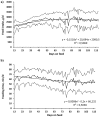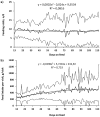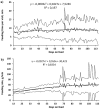The influence of feeding behaviour on growth performance, carcass and meat characteristics of growing pigs
- PMID: 30321211
- PMCID: PMC6188860
- DOI: 10.1371/journal.pone.0205572
The influence of feeding behaviour on growth performance, carcass and meat characteristics of growing pigs
Abstract
This study investigated the effect of the feeding behaviour on growth performance, and carcass and meat characteristics of 96 barrows fed ad libitum or restrictively with high or low amino acids (AA) diets according to a 2 × 2 factorial design. The feeding behaviour traits were measured with automated feeders. From 86 kg BW, half of the pigs were given feeds with high indispensable (AA) contents, while the other half received feeds with indispensable AA contents reduced by 9% in early finishing (86-118 kg BW) and by 18% in late finishing (118-145 kg BW). Body lipid and protein retentions were estimated from BW and backfat depth measures recorded at the beginning and end of each period. Pigs were slaughtered at 145 kg BW and carcass and meat quality data were recorded. Phenotypic correlations among feeding behaviours, growth performances, and carcass and meat traits were computed from all the data after adjustment for the effects of feeding treatments. As feeding rate was the behavioural trait most highly correlated with performance and carcass traits, the records of each pig were classified into feeding rate tertiles. Then, the data were statistically analysed using a mixed model, which included feed restriction (FR), AA reduction (AAR), the FR × AAR interaction and the feeding rate tertile as fixed factors, and pen as a random factor. Pigs eating faster (52.1 to 118.9 g/min) had significantly greater final body weights (16%), average daily weight gains (27%), estimated protein gains (22%), estimated lipid retention (46%), carcass weights (16%), weights of lean cuts (14%), weights of fat cuts (21%), proportions of fat in the carcass (14%), and 4% lower proportions of carcass lean cuts than pigs eating slowly (12.6 to 38.2 g/min). Manipulating the eating rate, through management or genetic strategies, could affect feed intake and subsequent growth performance, hence carcass quality, but have little influence on feed efficiency.
Conflict of interest statement
This project was funded in part by Veronesi SPA (Quinto di Valpantena, Verona, Italy). This financial support does not alter the authors’ adherence to PLOS ONE policies on sharing data and material.
Figures



Similar articles
-
Effects of feed allowance and indispensable amino acid reduction on feed intake, growth performance and carcass characteristics of growing pigs.PLoS One. 2018 Apr 5;13(4):e0195645. doi: 10.1371/journal.pone.0195645. eCollection 2018. PLoS One. 2018. PMID: 29621327 Free PMC article.
-
Effects of dietary vitamin E and fat supplementation in growing-finishing swine fed to a heavy slaughter weight of 150 kg: I. Growth performance, lean growth, organ size, carcass characteristics, primal cuts, and pork quality.J Anim Sci. 2022 Apr 1;100(4):skac081. doi: 10.1093/jas/skac081. J Anim Sci. 2022. PMID: 35289901 Free PMC article.
-
Impact of nursery feeding program on subsequent growth performance, carcass quality, meat quality, and physical and chemical body composition of growing-finishing pigs.J Anim Sci. 2014 Mar;92(3):1044-54. doi: 10.2527/jas.2013-6743. Epub 2014 Feb 3. J Anim Sci. 2014. PMID: 24492546 Clinical Trial.
-
Insights into the influence of diet and genetics on feed efficiency and meat production in sheep.Anim Genet. 2024 Feb;55(1):20-46. doi: 10.1111/age.13383. Epub 2023 Dec 19. Anim Genet. 2024. PMID: 38112204 Free PMC article. Review.
-
A review of robotic and automated systems in meat processing.Front Robot AI. 2025 May 23;12:1578318. doi: 10.3389/frobt.2025.1578318. eCollection 2025. Front Robot AI. 2025. PMID: 40485769 Free PMC article. Review.
Cited by
-
Feeding Behaviour in Group-Housed Growing-Finishing Pigs and Its Relationship with Growth and Feed Efficiency.Vet Sci. 2025 Feb 13;12(2):168. doi: 10.3390/vetsci12020168. Vet Sci. 2025. PMID: 40005928 Free PMC article.
-
Use of Host Feeding Behavior and Gut Microbiome Data in Estimating Variance Components and Predicting Growth and Body Composition Traits in Swine.Genes (Basel). 2022 Apr 26;13(5):767. doi: 10.3390/genes13050767. Genes (Basel). 2022. PMID: 35627152 Free PMC article.
-
Impact of Rearing Strategies on the Metabolizable Energy and SID Lysine Partitioning in Pigs Growing from 90 to 200 kg in Body Weight.Animals (Basel). 2022 Mar 9;12(6):689. doi: 10.3390/ani12060689. Animals (Basel). 2022. PMID: 35327086 Free PMC article.
-
The Feeding Behaviour Habits of Growing-Finishing Pigs and Its Effects on Growth Performance and Carcass Quality: A Review.Animals (Basel). 2022 Apr 28;12(9):1128. doi: 10.3390/ani12091128. Animals (Basel). 2022. PMID: 35565555 Free PMC article. Review.
-
Exploring the role of gut microbiota in host feeding behavior among breeds in swine.BMC Microbiol. 2022 Jan 3;22(1):1. doi: 10.1186/s12866-021-02409-6. BMC Microbiol. 2022. PMID: 34979903 Free PMC article.
References
-
- de Haer LCM, Luiting P, Aarts HLM. Relationship between individual (residual) feed intake and feed intake pattern in group housed growing pigs. Livest. Prod. Sci. 1993, 36: 233–253.
-
- Colpoys JD, Johnson AK, Gabler NK. Daily feeding regimen impacts pig growth and behavior. Physiol. & Behav. 2016, 159: 27–32. - PubMed
-
- de Haer LCM, de Vries AG. Feed intake patterns of and feed digestibility in growing pigs housed individually or in groups. Livest. Prod. Sci. 1993, 33: 277–292.
-
- Labroue F, Guéblez R, Sellier P, Meunier-Salaün MC. Feeding behaviour of group-housed Large White and Landrace pigs in French central test stations. Livest. Prod. Sci. 1994, 40: 303–312.
Publication types
MeSH terms
Substances
LinkOut - more resources
Full Text Sources
Medical
Research Materials

